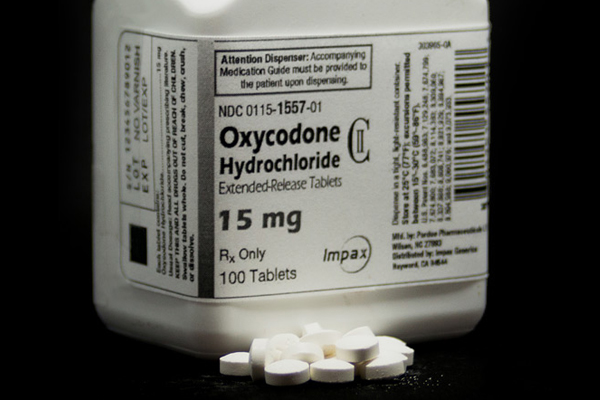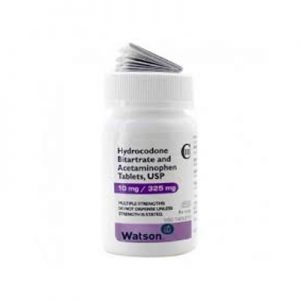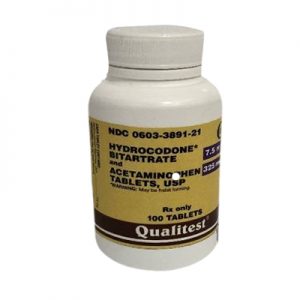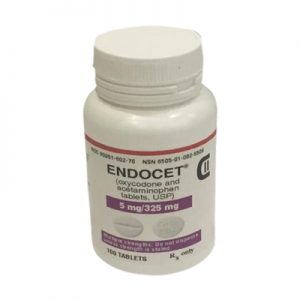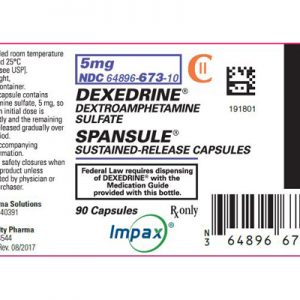Description
ORDER OXYCODONE 15 MG HYDROCHLORIDE IMPAX TABLETS ONLINE.
Oxycodone 15 mg Hydrochloride Impax Tablets is the powerful main ingredient in narcotic painkillers for moderate to severe pain. It is often administered orally to treat short-term dental and injury-related pain.
ROXICODONE® (oxycodone hydrochloride tablets USP) is an opioid analgesic.
Each tablet for oral administration contains 5 mg, 15 mg or 30 mg of oxycodone hydrochloride USP.
Oxycodone hydrochloride is a white, odorless crystalline powder derived from the opium alkaloid, thebaine. Oxycodone hydrochloride dissolves in water (1 g in 6 to 7 mL) and is considered slightly soluble in alcohol (octanol water partition coefficient is 0.7).
Chemically, oxycodone hydrochloride is 4, 5?-epoxy-14-hydroxy-3-methoxy-17-methylmorphinan-6- one hydrochloride
The 5 mg ROXICODONE® tablet contains inactive ingredients: microcrystalline cellulose and stearic acid. The 15 mg and 30 mg tablets contain the following inactive ingredients: microcrystalline cellulose; sodium starch glycolate; corn starch; lactose; stearic acid; D&C Yellow No. 10 (15 mg tablet); and FD&C Blue No. 2 (15 mg and 30 mg tablets).
The 5 mg, 15 mg and 30 mg tablets contain the equivalent of 4.5 mg, 13.5 mg and 27.0 mg, respectively, of oxycodone free base.
ROXICODONE® tablets are an immediate-release oral formulation of oxycodone hydrochloride indicated for the management of moderate to severe pain where the use of an opioid analgesic is appropriate.
OXYCODONE 15 MG HYDROCHLORIDE IMPAX DOSAGE AND ADMINISTRATION
ROXICODONE® is intended for the management of moderate to severe pain in patients who require treatment with an oral opioid analgesic. The dose should be individually adjusted according to severity of pain, patient response and patient size. If the pain increases in severity, if analgesia is not adequate, or if tolerance occurs, a gradual increase in dosage may be required.
Patients who have not been receiving opioid analgesics should be started on ROXICODONE® in a dosing range of 5 to 15 mg every 4 to 6 hours as needed for pain. The dose should be titrated based upon the individual patient’s response to their initial dose of ROXICODONE® . Patients with chronic pain should have their dosage given on an around-the-clock basis to prevent the reoccurrence of pain rather than treating the pain after it has occurred. This dose can then be adjusted to an acceptable level of analgesia taking into account side effects experienced by the patient.
CAN I BUY OXYCODONE 30MG ONLINE USA | WHERE TO ORDER ROXICODONE 30MG ONLINE USA
For control of severe chronic pain, ROXICODONE® should be administered on a regularly scheduled basis, every 4 to 6 hours, at the lowest dosage level that will achieve adequate analgesia.
As with any potent opioid, it is critical to adjust the dosing regimen for each patient individually, taking into account the patient’s prior analgesic treatment experience. Although it is not possible to list every condition that is important to the selection of the initial dose of ROXICODONE® , attention should be given to: 1) the daily dose, potency, and characteristics of a pure agonist or mixed agonist/antagonist the patient has been taking previously, 2) the reliability of the relative potency estimate to calculate the dose of oxycodone needed, 3) the degree of opioid tolerance, 4) the general condition and medical status of the patient, and 5) the balance between pain control and adverse experiences.
CONVERSION FROM FIXED-RATIO OPIOID/ACETAMINOPHEN, OPIOID/ASPIRIN, OR OPIOID/NONSTEROIDAL
COMBINATION DRUGS
When converting patients from fixed ratio opioid/non-opioid drug regimens a decision should be made whether or not to continue the non-opioid analgesic. If a decision is made to discontinue the use of nonopioid analgesic, it may be necessary to titrate the dose of ROXICODONE® in response to the level of analgesia and adverse effects afforded by the dosing regimen. If the non-opioid regimen is continued as a separate single entity agent, the starting dose ROXICODONE® should be based upon the most recent dose of opioid as a baseline for further titration of oxycodone. Incremental increases should be gauged according to side effects to an acceptable level of analgesia.
PATIENTS CURRENTLY ON OPIOID THERAPY
If a patient has been receiving opioid-containing medications prior to taking ROXICODONE® , the potency of the prior opioid relative to oxycodone should be factored into the selection of the total daily dose (TDD) of oxycodone.
In converting patients from other opioids to ROXICODONE® close observation and adjustment of dosage based upon the patient’s response to ROXICODONE® is imperative. Administration of supplemental analgesia for breakthrough or incident pain and titration of the total daily dose of ROXICODONE® may be necessary, especially in patients who have disease states that are changing rapidly.
MAINTENANCE OF THERAPY
Continual re-evaluation of the patient receiving ROXICODONE® is important, with special attention to the maintenance of pain control and the relative incidence of side effects associated with therapy. If the level of pain increases, effort should be made to identify the source of increased pain, while adjusting the dose as described above to decrease the level of pain.
During chronic therapy, especially for non-cancer-related pain (or pain associated with other terminal illnesses), the continued need for the use of opioid analgesics should be re-assessed as appropriate.
CESSATION OF THERAPY
When a patient no longer requires therapy with Oxycodone 15 mg Hydrochloride Impax or other opioid analgesics for the treatment of their pain, it is important that therapy be gradually discontinued over time to prevent the development of an opioid abstinence syndrome (narcotic withdrawal). In general, therapy can be decreased by 25% to 50% per day with careful monitoring for signs and symptoms of withdrawal (see Drug Abuse And Dependence section for description of the signs and symptoms of withdrawal). If the patient develops these signs or symptoms, the dose should be raised to the previous level and titrated down more slowly, either by increasing the interval between decreases, decreasing the amount of change in dose, or both. It is not known at what dose of ROXICODONE® that treatment may be discontinued without risk of the opioid abstinence syndrome.
HOW SUPPLIED
ROXICODONE®® (oxycodone hydrochloride tablets USP) are available as follows:
5 mg white tablets scored (Identified 54 582)
[Embossed 54 582 on one side]
NDC 23635-580-25: Unit Dose, 25 tablets per card, 4 cards per shipper
NDC 23635-580-10: Bottles of 100 tablets
15 mg green tablets scored (Identified 54 710)
[Embossed 54 710 on one side]
NDC 23635-581-10: Bottles of 100 tablets
30 mg blue tablets scored (Identified 54 199)
[Embossed 54 199 on one side]
NDC 23635-582-10: Bottles of 100 tablets
DEA Order Form Required
Dispense in a tight, light-resistant container.
Protect from moisture.
Store at 25°C (77°F); excursions are permitted to 15° to 30°C (59° to 86°F) [see USP Controlled Room Temperature].
Mallinckrodt, the “M” brand mark, the Mallinckrodt Pharmaceuticals logo and other brands are trademarks of a Mallinckrodt company.
Oxycodone 15 mg Hydrochloride Impax, ROXICODONE® tablets have been evaluated in open label clinical trials in patients with cancer and nonmalignant pain. ROXICODONE® tablets are associated with adverse experiences similar to those seen with other opioids.
Serious adverse reactions that may be associated with ROXICODONE® therapy in clinical use are those observed with other opioid analgesics and include: respiratory depression, respiratory arrest, circulatory depression, cardiac arrest, hypotension, and/or shock (see OVERDOSE, WARNINGS).
The less severe adverse events seen on initiation of therapy with Oxycodone 15 mg Hydrochloride Impax are also typical opioid side effects. These events are dose dependent, and their frequency depends on the clinical setting, the patient’s level of opioid tolerance, and host factors specific to the individual. They should be expected and managed as a part of opioid analgesia. The most frequent of these include nausea, constipation, vomiting, headache, and pruritus.
In many cases the frequency of adverse events during initiation of opioid therapy may be minimized by careful individualization of starting dosage, slow titration and the avoidance of large rapid swings in plasma concentration of the opioid. Many of these adverse events will abate as therapy is continued and some degree of tolerance is developed, but others may be expected to remain throughout therapy.
In all patients for whom dosing information was available (n=191) from the open-label and double-blind studies involving Oxycodone 15 mg Hydrochloride Impax , the following adverse events were recorded in ROXICODONE® treated patients with an incidence ? 3%. In descending order of frequency they were: nausea, constipation, vomiting, headache, pruritus, insomnia, dizziness, asthenia, and somnolence.
The following adverse experiences occurred in less than 3% of patients involved in clinical trials with oxycodone:
BODY AS A WHOLE
abdominal pain, accidental injury, allergic reaction, back pain, chills and fever, fever, flu syndrome, infection, neck pain, pain, photosensitivity reaction, and sepsis.

